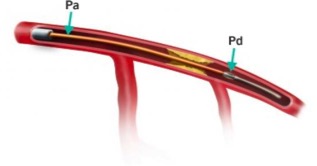[1]
Demir OM,Mitomo S,Mangieri A,Ancona MB,Regazzoli D,Lanzillo G,Giannini F,Testa L,Wijns W,Colombo A,Latib A, Diagnostic Accuracy of Microcatheter Derived Fractional Flow Reserve. The American journal of cardiology. 2019 Apr 25;
[PubMed PMID: 31104777]
[2]
Leipsic J,Anastasius M,Blanke P, Plaque, Pressure, and Risk: The Story Unfolds. Journal of the American College of Cardiology. 2019 May 21;
[PubMed PMID: 31097162]
[3]
Villines TC, Computed Tomography-Derived Fractional Flow Reserve: A Needed ADVANCE or Expensive Nicety? JACC. Cardiovascular imaging. 2019 May 9;
[PubMed PMID: 31103582]
[4]
Lee JM,Choi KH,Koo BK,Park J,Kim J,Hwang D,Rhee TM,Kim HY,Jung HW,Kim KJ,Yoshiaki K,Shin ES,Doh JH,Chang HJ,Cho YK,Yoon HJ,Nam CW,Hur SH,Wang J,Chen S,Kuramitsu S,Tanaka N,Matsuo H,Akasaka T, Prognostic Implications of Plaque Characteristics and Stenosis Severity in Patients With Coronary Artery Disease. Journal of the American College of Cardiology. 2019 May 21;
[PubMed PMID: 31097161]
[5]
Neupane S,Singh H,Edla S,Altujjar M,Yamsaki H,Lalonde T,Rosman HS,Eggebrecht H,Mehta RH, Meta-analysis of fractional flow reserve guided complete revascularization versus infarct related artery only revascularization in patients with ST-elevation myocardial infarction and multivessel coronary artery disease. Coronary artery disease. 2019 May 14;
[PubMed PMID: 31094897]
Level 1 (high-level) evidence
[6]
Masdjedi K,van Zandvoort LJC,Balbi MM,Gijsen FJH,Ligthart JMR,Rutten MCM,Lemmert ME,Wilschut J,Diletti R,De Jaegere P,Zijlstra F,Van Mieghem NM,Daemen J, Validation of 3-Dimensional Quantitative Coronary Angiography based software to calculate Fractional Flow Reserve: Fast Assessment of STenosis severity (FAST)-study. EuroIntervention : journal of EuroPCR in collaboration with the Working Group on Interventional Cardiology of the European Society of Cardiology. 2019 May 14;
[PubMed PMID: 31085504]
Level 1 (high-level) evidence
[7]
Fournier S,Toth GG,Colaiori I,De Bruyne B,Barbato E, Long-Term Patency of Coronary Artery Bypass Grafts After Fractional Flow Reserve-Guided Implantation. Circulation. Cardiovascular interventions. 2019 May;
[PubMed PMID: 31084238]
[8]
Whayne TF Jr,Sousa MJ,Abdel-Latif A, Use and Value of Fractional Flow Reserve in Coronary Arteriography. Angiology. 2019 May 13;
[PubMed PMID: 31084188]
[9]
Abo-Aly M,Lolay G,Adams C,Ahmed AE,Abdel-Latif A,Ziada KM, Comparison of intracoronary versus intravenous adenosine-induced maximal hyperemia for fractional flow reserve measurement: A systematic review and meta-analysis. Catheterization and cardiovascular interventions : official journal of the Society for Cardiac Angiography
[PubMed PMID: 31074100]
Level 1 (high-level) evidence
[10]
Patel AR,Maffessanti F,Patel MB,Kebed K,Narang A,Singh A,Medvedofsky D,Zaidi SJ,Mediratta A,Goyal N,Kachenoura N,Lang RM,Mor-Avi V, Hemodynamic impact of coronary stenosis using computed tomography: comparison between noninvasive fractional flow reserve and 3D fusion of coronary angiography with stress myocardial perfusion. The international journal of cardiovascular imaging. 2019 May 9;
[PubMed PMID: 31073698]

